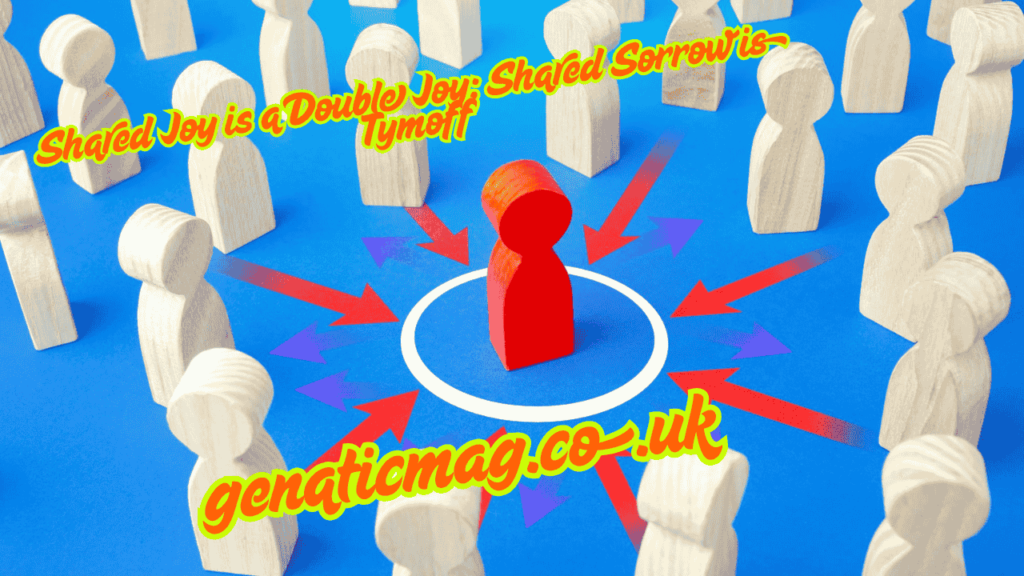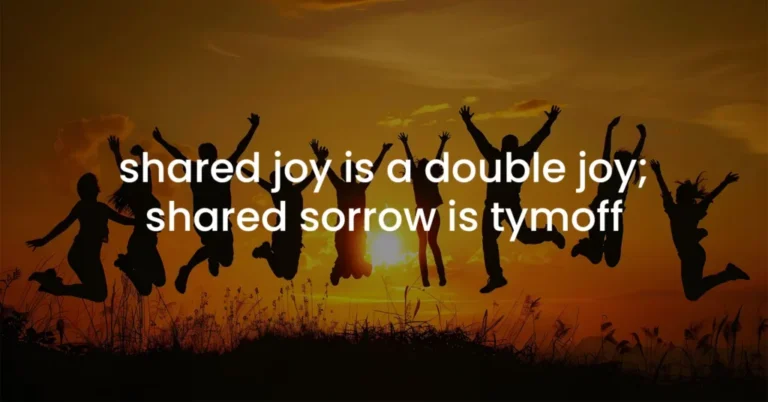In a society continually evolving and often distinguished by individual goals and personal ambitions, the old saying, “Shared Joy is a Double Joy; Shared Sorrow is Tymoff??”, emerges as a potent reminder of the value of human connection. Though the statement may confound at first glance with the enigmatic “Tymoff” at the end, it holds layers of emotional, psychological, and philosophical meaning. It argues that when delight is shared, it increases, and when grief is shared, it reduces or at least becomes more manageable. This essay dives deep into this statement, investigating its consequences through the viewpoint of psychology, relationships, community, and the present digital world.
The Psychology Behind Shared Emotions

Emotions are not lonely experiences. They are contagious, influential, and intensely social. According to psychological study, joy releases dopamine and serotonin—the brain’s “feel-good” chemicals. When shared, these feelings not only amplify within the individual but also influence those around them positively. Think about the infectious effect of a genuine grin or honest laughter in a room. When someone shares their delight, it frequently improves the mood of others as well.
On the contrary, suffering shared does not double; rather, it finds relief. The phrase “Shared Sorrow is Tymoff” may signify a comforting pause—a time off from emotional weight. When we communicate our melancholy, we engage in emotional unloading, which helps relieve tension, anxiety, and feelings of loneliness. Talking through pain with someone empathetic gives a space where healing can begin.
The Role of Relationships: A Mirror of Shared Joy and Sorrow

Close relationships, whether family, romantic, or platonic, are based on the foundations of emotional exchange. Shared delight in these partnerships develops links, celebrates togetherness, and reinforces mutual respect and affection. The celebration of triumphs, milestones, or even minor daily victories becomes more important when enjoyed with another.
In contrast, shared sadness tests the strength and validity of these ties. When individuals stand by one other in times of grief, loss, or failure, they form a network of support that fosters resilience. “Tymoff,” in this context, could metaphorically represent a moment of unity—a phase where sorrow rests in the midst of understanding and compassion. It’s not about eradicating pain but about not having to endure it alone.
The Community Effect: A Collective Consciousness

Communities thrive on shared experiences. Cultural festivals, communal rituals, and even national events are expressions of collective joy. These shared moments create a sense of belonging, strengthening communal identity. Joy, when multiplied through such collective consciousness, becomes a societal asset.
Equally crucial is the communal response to tragedy. Natural disasters, social injustices, or personal losses often draw people together in solidarity. Communities rally to support victims, raise donations, offer counseling, or simply be present. Shared sadness, in this collective attitude, creates the foundation for empathy-driven action. The cryptic “Tymoff” may indicate the brief time of stop society takes to contemplate, heal, and then rebuild.
Digital Age Sharing: A Double-Edged Sword
In today’s hyper-connected society, social media platforms have redefined what it means to convey joy or grief. Announcements of engagements, promotions, or personal successes receive hundreds of likes and comments, delivering quick gratification. This public sharing of joy may appear to double the emotion, but it also carries the risk of superficial approval.
Similarly, when sorrow is shared online, it may elicit support and empathy, yet it can also be met with apathy or even exploitation. The phrase “Shared Sorrow is Tymoff??” raises questions about the authenticity and depth of digital empathy. Is sharing sorrow online a genuine catharsis or a plea for attention? The answer varies, but the underlying truth remains: true relief comes not from likes but from genuine emotional connection.
The Healing Nature of Storytelling
Storytelling is an ancient tool used for emotional expression. Narratives of personal achievements and misfortunes have always resonated with audiences because they mirror universal human experiences. By telling our tales, we share our delight, motivating others. By exposing our sorrow, we encourage compassion and understanding.
“Shared Joy is a Double Joy; Shared Sorrow is Tymoff” in the framework of narrative, then, becomes a pattern for emotional healing. The act of narrating one’s emotions—whether in a diary, a blog post, or a conversation—is therapeutic. And the act of listening or reading is as powerful, allowing others to connect and respond.
The Philosophical Perspective: Why Sharing Matters
From a philosophical viewpoint, human beings are naturally social animals. Aristotle once observed, “Man is by nature a social animal.” Our lives find purpose in relationships and shared experiences. Happiness is magnified in the company of others since it confirms our existence and achievements. Similarly, sorrow loses part of its sting when witnessed by someone who cares.
The phrase’s ambiguity, especially the word “Tymoff,” may be interpreted as a poetic or symbolic device—perhaps representing a mystical element, a pause, or a healing space that forms only through connection. When joy and sorrow are kept within, they stagnate; when shared, they transform.
Conclusion: The Essence of Being Human
In conclusion, “Shared Joy is a Double Joy; Shared Sorrow is Tymoff??” is more than just a proverb—it is a philosophy, a psychological truth, and a societal necessity. The doubling of joy through sharing enriches not just the individual but the community. The lessening of sorrow through sharing provides comfort, connection, and healing.
The cryptic nature of “Tymoff??” only adds to the intrigue, perhaps reminding us that not everything needs to be fully understood to be meaningful. Sometimes, emotions transcend words. What matters most is that they are shared. That act of opening one’s heart—to celebrate, to grieve, to connect—is the most human act of all.
So the next time you’re overwhelmed with joy, find someone to share it with. And if sorrow weighs heavy on your heart, don’t bear it alone. In both cases, you’ll discover that the act of sharing is the key to multiplying happiness and softening pain. That is the essence behind “Shared Joy is a Double Joy; Shared Sorrow is Tymoff??”
Also Read : Shared Joy is a Double Joy; Shared Sorrow is Tymoff
